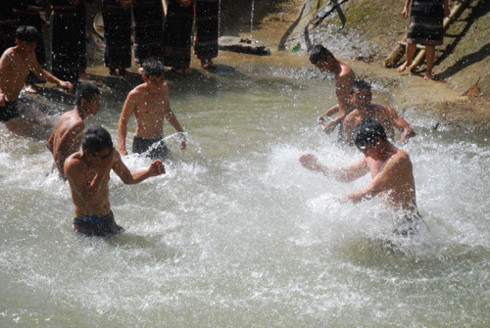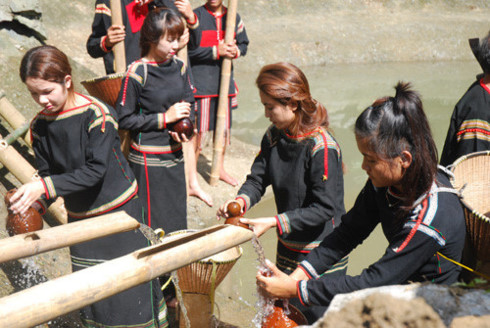Water resource worship is a unique ritual of the Ede in the Central Highlands. It’s held annually to pay tribute to the water genie, who has brought them happiness in the old year, and pray for good fortune in the new year.

The shaman performs the ritual (photo: Hoang Anh/ Bao Tin Tuc)
Living in deep forests and on high mountains, the Ede depend largely on nature. Fire and water are essential elements in their lives. Long ago, when the Ede were looking for new places to settle, vanguard groups had to find fertile land with abundant water resources.
Nguyen Hong Ky, a researcher of Central Highlands Culture, said, "The Central Highlands has two seasons. The dry season is scorching hot. Ede legends say that in the dry reason, Central Highlanders had to drink night dews. Water resources are a very important part of their lives.”

After the ritual, young people play with the water (photo: Hoang Anh/ Bao Tin Tuc)
In the last month of the Lunar Year, when the harvest is complete, the Ede worship the water genies and others for giving them sufficient water and bumper crops.
The village chief meets with all the villagers and tells them to prepare for the ceremony. Strong young men dredge the local water source and repair the path from it to the village.
Women and old people clean and decorate the village. A high-status man conducts the water worship ceremony.

Ede girls fetch water to their homes (photo: Hoang Anh/ Bao Tin Tuc)
I Duc E Ban, an Ede elder, said, “The owner of the water resource is a patriarch or a prestigious man of the clan. He decides the offerings and manages the ceremony.”
A gate made of leaves is installed at the water resource to remind people not to fetch water on the worship day. The offerings include a pig and a large container of alcohol. As with other ceremonies, gong performances are an indispensable part of the water worship.

The shaman shares the offerings among villagers (photo: Hoang Anh/ Bao Tin Tuc)
The shaman reads prayers for health and abundant, clean water all year round. They pray to their ancestors to bless their offspring with unity and fidelity. Then all the villagers fetch water home in gourds or papooses.
A group of people accompany the shaman to each household to pray for the family. Finally, they gather in their communal house to enjoy a party and dance.
Today, Ede villages have wells, but the water worship ritual has been maintained. It’s not just a religious ritual, it reminds the villagers to protect nature especially water resources, for the community’s continued well-being.